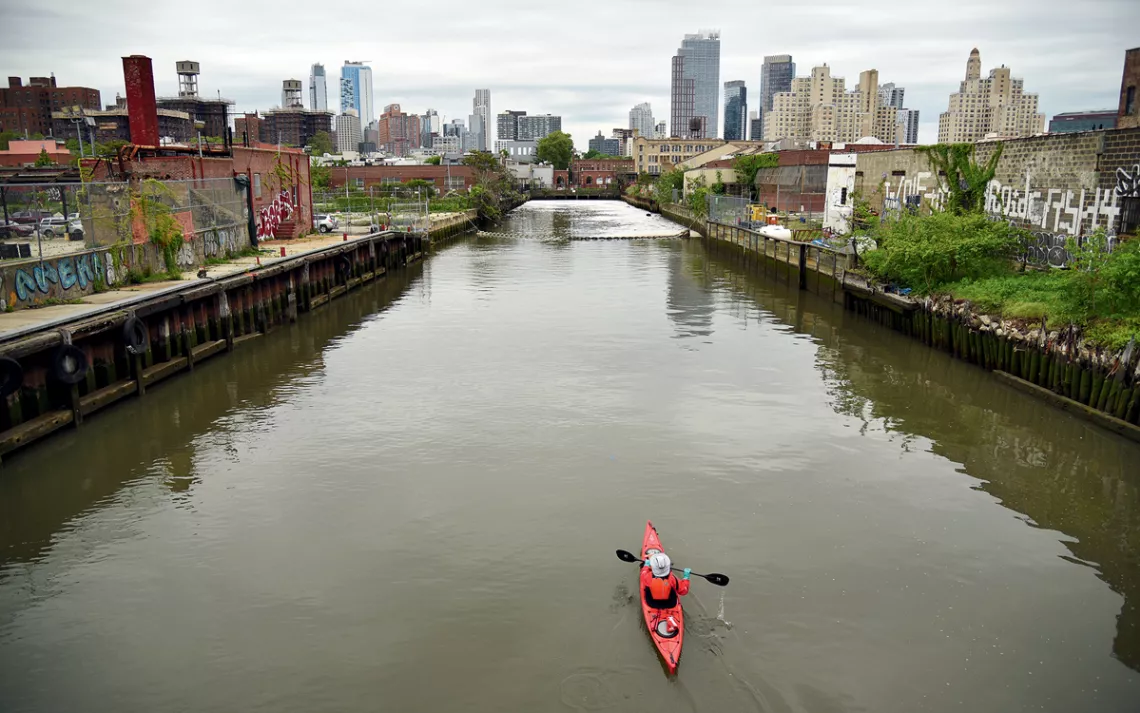Brooklyn's Infamous Superfund Site: Also a Wildlife Haven
How to clean up the Gowanus Canal? It's complicated.

Brooklyn's Gowanus Canal is a haven for wildlife and a popular spot for recreation. It's also a Superfund site. | Photo by Nathan Kensinger
A favorite pastime among local residents who stroll the banks of Brooklyn's Gowanus Canal is watching coal-tar rainbow swirls burble to the water's surface next to the Bayside Fuel Oil Depot after a heavy rain.
"Look at these from last week!" said Gary Francis, a member of the Gowanus Dredgers Canoe Club, as he showed me photos of vividly blue and pink mini oil slicks on his phone. He had other things to show me. We paddled down the 100-foot-wide canal, which zigzags for almost two miles across the New York City borough, and Francis excitedly pointed out mussels and eastern oysters wedged into the grooves of tires lining the underside of a Gowanus bridge. "Their spat may have floated in from the bay."
Studded with welders, machine shops, and toxic brownfields, the Gowanus Canal has served as an industrial conduit for 150 years. As a result, it is rife with lead, copper, PCBs, pesticides, arsenic, raw sewage, and the bacteria that cause gonorrhea and chlamydia. The canal's bottom is lined with a sludge the locals call "black mayonnaise." On its route to New York Harbor, the Gowanus picks up metal dust from a scrapyard and trash windblown from parking lots. In 2013, the EPA declared it a Superfund site and began planning for a major cleanup.
Brooklyn wildlife lovers see it differently—as a haven for flora and fauna. In early spring, goose couples can be seen snuggling atop rotten pilings. The greenery up and down the banks harbors bees and raccoons. Community-science "bio blitzes" have cataloged 1,140 species in and along the canal, including Atlantic mussels, blue crabs, eastern oysters, mud snails, American eels, striped bass, Atlantic silversides, black swallowtails, swamp darners, least flycatchers, black-crowned night herons, green frogs, and inky cap mushrooms.
Now, many community members worry that the Superfund cleanup may do irreparable harm. Steel bulkheads are starting to replace the stone and wood canal sides, and a concrete cap will eventually cover the black mayonnaise.
"We call it the sterile box," said Diana Gruberg, a landscape director at the nonprofit Gowanus Canal Conservancy (GCC). Nothing—not contaminants, plants, water grasses, or mollusks—can attach to those smooth steel surfaces. As a result, "we're losing habitat with the cleanup, and with that comes the elimination of all that biodiversity."
The conservancy has spent the past 10 years trying to tell anyone who'd listen what the canal could look like if it were restored to an ecologically rich salt marsh—the likes of which would have been familiar to the Indigenous Lenape who lived there before European colonization. The GCC coaxed a proof-of-concept idyll from part of a 1.4-acre triangle of city-owned land called the Salt Lot, which juts into the canal across from a cement plant. There, the conservancy planted over 100 species of flora, including seaside goldenrod, wild bergamot, and bee balm, alongside impromptu outcroppings of honey locust, mulberry, nightshade, and knotweed. These plants slow the flooding of the surrounding neighborhood during heavy rain events—a sort of naturalist's stormwater infrastructure—in addition to feeding and sheltering wildlife.
Gena Wirth, a designer at Scape Landscape Architecture, which helped the conservancy come up with a broader salt marsh plan, is also seeking potential habitat solutions. Some are as simple as purposely frayed "fuzzy ropes"—used in aquaculture to attract and grow mollusks—which her firm stuck in the water farther south in Brooklyn. Wirth said that native plantings of the sort at the Salt Lot could likely support all manner of native bees and butterflies and moths, if landscapers could figure out how to create "long, extended flowering seasons that overlap from very early spring to late fall" for the extent of the canal's length.
A few months ago, though, the EPA closed the Salt Lot garden to make way for a 4-million-gallon retention tank to help with sewage overflow. GCC staff and volunteers gloomily dismembered the garden and set up temporary shop elsewhere. They are hoping to reclaim and replant the Salt Lot space sometime in 2024.
In the meantime, Francis is working on his own plan to recruit mollusks to recolonize the canal. He's experimenting with prototypes he calls "mussel nodes." One afternoon, he poured a fast-setting cement slurry into a silicone mold, stuck in a loop of rope, and several minutes later, gave it a tug. Out popped a hardened gray cluster of faux mussels. They were ribbed and striated just like the real things, with nooks and crannies that spat could theoretically latch on to. Francis has already lowered several of these nodes into the canal. "There was a little sculpin right in the middle, and we've had crabs come up on them," he said.
Alas, no mollusks yet.
This article appeared in the Summer 2022 quarterly edition with the headline "A Canal Flows in Brooklyn."
 The Magazine of The Sierra Club
The Magazine of The Sierra Club



